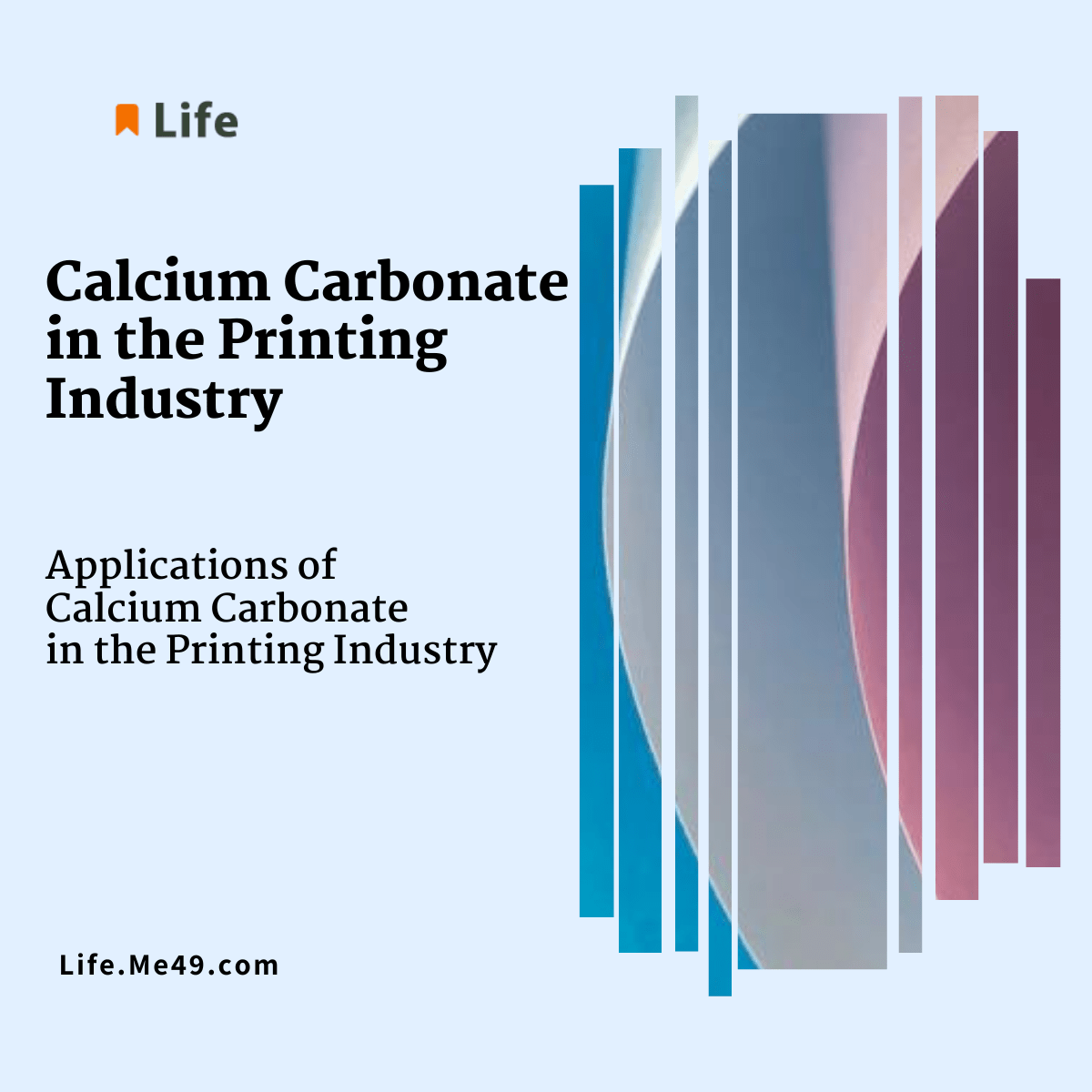Applications of Calcium Carbonate in the Printing Industry
The realm of the printing industry stands as a dynamic and ever-evolving field, constantly shaped by the march of technological progress and the shifting tides of market requirements.
Amidst this ceaseless transformation, one fundamental element has emerged as an unsung hero – calcium carbonate.
This unassuming mineral compound, with its rich tapestry of attributes and capabilities, assumes a central role in elevating the efficiency, precision, quality, and eco-friendliness of a wide array of printing processes.
In this extensive and all-encompassing discourse, we embark on a journey to explore the expansive landscape of calcium carbonate’s applications within the printing industry, revealing the multifaceted nature of its contributions that often go unnoticed but are, without a doubt, indispensable.
Calcium Carbonate: A Printing Industry Ally
The Role of Calcium Carbonate
Calcium carbonate, denoted by its chemical formula CaCO3, is a remarkable mineral that exists abundantly in nature, manifesting itself in various geological formations such as limestone, chalk, and marble.
These diverse forms underscore its versatility and accessibility.
It is precisely these distinctive characteristics and inherent properties that render calcium carbonate an invaluable resource within the intricate realm of the printing industry, where the pursuit of precision, exceptional quality, and unwavering commitment to sustainability reign supreme.
In the following exploration, we will delve deeper into the specific attributes of calcium carbonate that make it an essential and multifaceted contributor to the world of printing.
** Improved Paper Smoothness
The incorporation of calcium carbonate into the papermaking process yields a cascade of benefits, with one notable outcome being the creation of paper surfaces that exhibit a heightened level of smoothness and uniformity.
This augmentation in surface texture is not merely superficial; rather, it serves as a critical foundation upon which the art of printing unfolds.
The amplified smoothness, which calcium carbonate imparts to paper, fosters an environment where ink application becomes a refined and precise endeavor.
The paper’s receptive surface, now flawlessly even, welcomes the ink with open arms, enabling it to be distributed in a more uniform and controlled manner.
This, in turn, translates into printouts that are not only crisper but also exude a vibrancy that leaps off the page.
The significance of this seemingly subtle transformation cannot be overstated, for it is this very attribute that allows printed content to be conveyed with utmost clarity and impact.
Whether it’s the fine details of a high-resolution image or the crispness of text in a book, the addition of calcium carbonate to paper pulp underpins the creation of printed materials that are a testament to precision and quality.
** Controlled Ink Absorption
Within the realm of paper production, calcium carbonate assumes a pivotal role as a filler, a role that extends beyond mere structural support.
This multifaceted mineral compound contributes significantly to the regulation of paper’s porosity, a characteristic that holds profound implications for the world of printing.
The strategic inclusion of calcium carbonate into the paper composition imbues it with the capacity to finely control ink absorption.
This controlled ink absorption is akin to orchestrating a delicate dance between the paper and the ink.
It’s a choreography where calcium carbonate acts as the choreographer, ensuring that the ink’s performance unfolds precisely as intended.
This precise control is a boon to the art of printing, for it achieves a harmonious balance.
Ink is neither absorbed too quickly, where it might feather and blur, nor too slowly, where it could result in dull and lackluster prints.
Instead, thanks to calcium carbonate’s meticulous influence, ink spreads evenly and adheres with just the right degree of adhesion.
The net result of this controlled ink absorption is printouts that stand as paragons of precision and clarity.
Fine lines are crisp, colors are vibrant, and text is sharp and legible.
In essence, calcium carbonate, as a paper filler, is an unsung hero in the world of printing, silently but masterfully ensuring that every print job achieves the pinnacle of excellence.
** Reduced Show-Through
In duplex printing, where both sides of the paper are used, calcium carbonate reduces “show-through,” ensuring that content on one side does not interfere with readability on the other.
Calcium Carbonate: Sustainable Printing Practices
** Lightweight Coatings
In the intricate process of crafting coated papers, calcium carbonate emerges as a key player, particularly in its role as a coating pigment.
This mineral’s unique attributes lend themselves to a symbiotic relationship with the world of printing, contributing to an array of advantages that extend well beyond the surface.
One of the standout qualities of calcium carbonate, when employed as a coating pigment, is its low density.
This seemingly simple characteristic carries profound implications for the production of printed materials.
It paves the way for the creation of coatings that are not only robust and effective but also remarkably lightweight.
The significance of lightweight coatings cannot be overstated.
These coatings, enriched with calcium carbonate, bestow printed materials with a distinct advantage.
While maintaining impeccable print quality, they manage to shed unnecessary bulk. This, in turn, results in printed materials that are notably lighter in weight.
The benefits ripple across the entire spectrum of the printing and publishing industry.
Reduced weight translates directly into lower shipping costs, an aspect of paramount importance in a world where logistics and transportation play pivotal roles.
Lower shipping costs not only boost economic feasibility but also reduce the carbon footprint associated with the distribution of printed materials.
It’s in this light that calcium carbonate’s contribution to environmental sustainability shines brightest.
By enabling the production of lighter printed materials, it actively participates in the reduction of greenhouse gas emissions, aligning seamlessly with the broader goals of eco-consciousness.
In summary, the utilization of calcium carbonate as a coating pigment in the production of coated papers yields outcomes that are nothing short of remarkable.
It strikes a balance between maintaining print quality and shedding unnecessary weight, resulting in printed materials that are both efficient and eco-friendly.
Calcium carbonate, in this context, serves as a beacon of innovation, guiding the printing industry toward a future characterized by excellence and environmental responsibility.
** Recyclability
Calcium carbonate’s presence in paper products aligns seamlessly with recycling processes.
During recycling, it helps in separating ink and impurities from paper fibers, facilitating the production of high-quality recycled paper.
** Lower Energy Consumption
Incorporating calcium carbonate into the intricate process of manufacturing paper coatings and fillers signifies a sustainable choice that reverberates across the entire production spectrum.
This choice hinges on a crucial attribute that sets calcium carbonate apart: its inherent energy efficiency.
Unlike many synthetic alternatives, the utilization of calcium carbonate in paper production consumes significantly less energy.
This fundamental difference in energy demand is pivotal, transcending mere cost considerations.
It directly contributes to a substantial reduction in greenhouse gas emissions, a critical goal in our contemporary pursuit of mitigating climate change.
The path to energy efficiency in calcium carbonate’s application lies in its natural origins and straightforward extraction and refinement processes.
Unlike synthetic counterparts that often necessitate energy-intensive manufacturing processes, calcium carbonate, drawn from abundant geological formations, requires comparatively less energy from extraction through to utilization.
This energy conservation extends across the entire lifecycle of paper production.
From the moment calcium carbonate is incorporated into coatings and fillers, it serves as a beacon of eco-friendliness.
It not only aids in creating superior paper products but does so with a substantially lower carbon footprint.
The implications of this choice radiate outward, affecting not only the efficiency of paper production but also its environmental impact.
Reduced greenhouse gas emissions represent a concrete step towards a more sustainable and environmentally responsible future, one where the printing industry treads lightly on the planet while maintaining exceptional quality and performance.
In essence, the decision to embrace calcium carbonate in paper production is a testament to the industry’s commitment to balancing progress with environmental stewardship.
It underscores the pivotal role that conscientious material choices play in the ongoing quest for sustainability and excellence in the modern printing world.
Calcium Carbonate: Quality and Efficiency in Printing
Diverse Printing Methods
** Offset Printing
In offset printing, calcium carbonate plays a pivotal role in producing sharp, high-quality images.
Its ability to control ink absorption and improve paper smoothness is particularly advantageous in this method.
** Gravure Printing
For gravure printing, which relies on engraved cylinders, calcium carbonate’s contribution to smooth paper surfaces ensures precise ink transfer, resulting in consistent and detailed prints.
** Lithography
Lithography benefits from calcium carbonate’s ability to maintain ink stability and prevent ink-water emulsions, ensuring accurate and vibrant color reproduction.
Inkjet Printing Advancements
** Inkjet Paper Coatings
In the realm of inkjet printing, specialized coatings containing calcium carbonate are employed to enhance color saturation and image resolution.
** Wide-Format Printing
Wide-format printers use calcium carbonate in coatings to achieve optimal ink absorption, preventing bleed and ensuring high-quality output for posters, banners, and other large-scale prints.
Eco-Friendly Packaging with Calcium Carbonate
** Flexible Packaging
Calcium carbonate is utilized in flexible packaging to reduce the weight of packaging materials while maintaining durability and print quality, contributing to eco-friendly packaging solutions.
** Corrugated Boxes
In the production of corrugated boxes, calcium carbonate is added to the adhesive layer to enhance bonding and reduce the need for additional materials, promoting sustainable packaging practices.
Conclusion
The applications of calcium carbonate in the printing industry are both diverse and indispensable.
From enhancing print quality and efficiency to promoting sustainability and recyclability, this mineral compound plays a pivotal role in shaping modern printing practices.
As the printing industry continues to evolve, calcium carbonate stands as a testament to the enduring synergy between technological innovation and environmentally responsible choices.
FAQs
How does calcium carbonate improve print quality?
Calcium carbonate enhances print quality by improving paper smoothness, controlling ink absorption, and reducing show-through.
Is calcium carbonate environmentally friendly in the printing industry?
Yes, calcium carbonate promotes sustainability through its contributions to lightweight coatings, recyclability, and lower energy consumption.
What printing methods benefit from calcium carbonate?
Calcium carbonate benefits offset printing, gravure printing, lithography, inkjet printing, and wide-format printing by enhancing print quality and efficiency.
How does calcium carbonate contribute to sustainable packaging?
Calcium carbonate reduces packaging weight while maintaining durability, making it an eco-friendly choice for flexible packaging and corrugated boxes.
Can calcium carbonate be used in inkjet printing?
Yes, calcium carbonate is used in inkjet paper coatings to enhance color saturation and image resolution.
What makes calcium carbonate a valuable resource in the printing industry?
Calcium carbonate’s ability to improve print quality, efficiency, and sustainability makes it a valuable resource in the printing industry.








